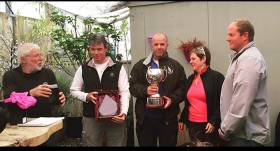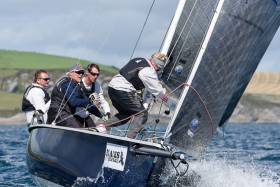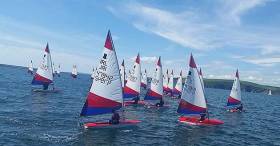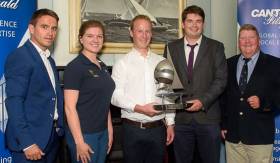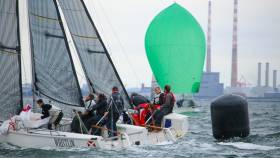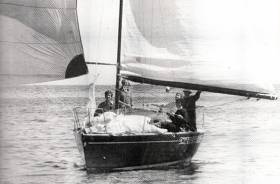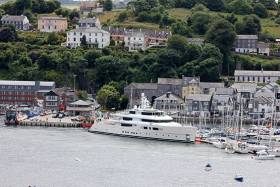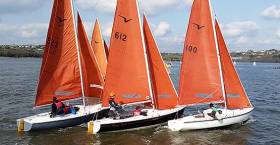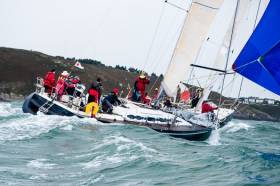Displaying items by tag: Kinsale Yacht Club
Kinsale Yacht Club's 'Little Fella' is Dragon South Coast Champion
Dragons from the Dun Laoghaire, Kinsale and UK fleets joined the large Glandore Harbour Yacht Club fleet for the Irish South Coast Championships last weekend.
Racing began on Friday in a fresh 15–knot breeze when International Race Officer, Alan Crosbie, added a third race to the schedule because of expected gales on Saturday.
Defending champion, Cameron Good sailing "Little Fella" from Kinsale, started well with two race wins and a third. David Williams in "Phantom" from the Royal St George YC was consistent ending their day with a 2,3,2.
Martin Byrne's "Jaguar Sailing Team" recovered well to finish 5th in race one but only after returning to the start line to pick up Adam Winkelmann who fell overboard after their first tack and got separated from the boat. The Royal St George YC sailors followed that drama with a 2nd and 1st to lie a close third overall at the end of day one.
On Friday evening Glandore Harbour Yacht Club, who now have the largest Dragon Fleet in Ireland, hosted an excellent reception for the competitors in their Clubhouse by the harbour.
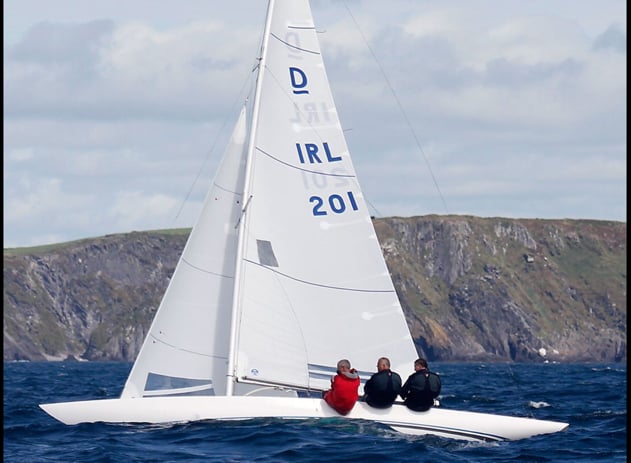 Martin Byrne's "Jaguar Sailing Team" recovered well to finish 5th in race one but only after returning to the start line to pick up Adam Winkelmann who fell overboard
Martin Byrne's "Jaguar Sailing Team" recovered well to finish 5th in race one but only after returning to the start line to pick up Adam Winkelmann who fell overboard
Saturday morning brought the expected gales and huge waves so Alan Crosbie made an early decision to cancel racing for the day. This allowed the competitors to enjoy the delights of West Cork in various locations from Skibereen to Schull and Baltimore before the championship dinner in Glandore village later that evening.
The expected forecast of 10 to 12 knots did not materialise on Sunday and the fleet of 17 Dragons had to wait until 1230hrs before race 4 started in a very light breeze. This turned out to be the only race of the day ahead of a deadline of 1400hrs. It turned out to be a competitive race with regular place changes in the shifting breeze.
With no discard coming into play the podium positions were all up for grabs and "Little Fella", "Jaguar" and "Phantom" finished 1st, 2nd & 3rd overall after keeping a close covering eye on each other in very a tactical race.
However it was Patrick Gifford, sailing "Basilisk" GBR 515, from Aldeburgh Yacht Club who won this race easily after leading at the top mark to move up and take 4th overall. Anthony O'Neill sailing "Tenacious" and Adrian Bendon in "Mar J", both from Kinsale were 5th & 6th overall.
The Dragon fleet remain on the South Coast for their National Championships which take place in Kinsale in two weeks time.
1720 Championship Victory for Peter O'Leary's 'Dutch Gold' in Kinsale
After missing out on Day 2 of the 1720 Irish championship entirely due to inclement weather, OOD Peter Crowley and his team were on the water at Kinsale before 09:00 this morning and managed to complete a full programme of races for the 1720 National Championships writes Peadar Murphy. The wind today was light and shifting, but four highly competitive races were still squeezed in and had everyone ashore just before the rain swept in again.
After the first four races on Friday, Anthony O’Leary on “Antix” led from the Byrne and Wilson outfit on “ZING” and Aoife English on “Atara”. However today, the next generation of O’Learys shot to the fore on “Dutch Gold” (newly arrived from Holland!) with Peter on the helm and Robert midship providing the fleet with a masterclass in 1720 sailing in light airs. Three bullets and a second place finish rightly crowning them as the 1720 National Champions for 2016 and bringing the title to Baltimore Sailing Club, capping off a memorable week for that part of the world!
Though never quite at the front of the fleet today, Padraig Byrne and Don Wilson on “ZING” had done enough on Friday to ensure that their lesser results today still merited a second place overall. The lighter airs today seemed to suit a number of boats that hadn’t been quite in the running in strong stuff on Friday; Fionn Lyden on Baltimore Sailing Club boat “Live Wire” had a strong showing today, and might have been pushed a bit by fellow Baltimore boat “Smile n’ Wave”, though their challenge ran out of steam later in the day. Also prominent today were Paul Gibbons’ “Wahoo” and Dun Laoghaire visitor Kenneth Rumball on “Team INSS”. However, despite an off day today - Anthony O”Leary’s “Antix” came home in third overall with five points to spare over “Wahoo”.
However, the undoubted winner of the Blacks of Kinsale 1720 National Championships was Peter O’Leary.
O'Leary Leads Kinsale–Based 1720 National Championships (Photo Gallery HERE)
After four races of the 1720 National Championships at Kinsale YC in County Cork this afternoon, Antix, skippered by Anthony O'Leary of Royal Cork, leads the 16–boat fleet by two points writes Bob Bateman.
Races were sailed in a 15-knot south westerly with Antix, the current 1720 European champion, counting two wins and two seconds. O'Leary's RCYC club mates Padraig Byrne & Don Wilson are second on eight points. In third place is Howth Yacht Club and Royal Cork entry Altara skippered by Aoife English on 21 points.
Fomer Euro champion boat MICAM skippered by Mel Collins from Baltimore SC was sixth in race one but sustained gear failure and did not compete in the next three.
Friday dawned dull and with light breezes for the 16-boat fleet of the Blacks of Kinsale 1720 National Championships. OOD Peter Crowley on “Sparetime” head south to roughly one mile south of Centrepoint and laid a course to the southwest over to Black Head. The first of three scheduled races got underway with the sun starting to break through the cloud and the promise of a great day’s sailing.
Race 1 quickly established the running order for the day, with Anthony O’Leary on “Antix” and the Padraig Byrne & Don Wilson team on “ZING” coming in first and second. By the time the second race started, the sun was well established and the wind had built up. Aoife English on “Atara” scored the sole bullet of the day not taken by “Antix” or “ZING’, but had both hot on her heels. Baltimore boats "Live Wire” and “MICAM” suffered issues during the race and neither finished the race, with “MICAM”’s broken lower spreader proving terminal to her racing for the day.
For Race 3, “Live Wire” were back in business, but Denis Murphy’s “Aquatack” were not in a position to start, denting what was otherwise shaping up to be a good day’s scoring for the RCYC boat. Another perennial front-of-fleet boat - Clive O’Shea’s and Tom Durcan’s “T-Bone” was another victim of conditions in Race 3 with “ZING” scoring her sole bullet of the day. With the sun bright in the sky, strong and steady winds and a forbidding forecast for Saturday, OOD Peter Crowley elected to run a fourth race.
Fans of full-blasting were served up a treat with boats screaming down the run on the plane, with plenty of hairy gybes and more than a few broaches and wipeouts. “T-Bone” didn’t make it to the finish for their second race in a row, and “Wahoo” from RCYC also having an off race for them with a DNF dropping them from a potential third place overall at the halfway point of the championship. “Antix” and “Zing” continued to lead the way, with O’Leary claiming the final bullet of the day. Crews returned to the marina in Kinsale with broad grins, sore limbs and more than a few ripped sails and damaged lines. The marina looked reminiscent of a team garage at a Formula 1 race as efforts were made to ready the boats for what lies ahead...
Provisional results below.
Munster Topper Championship Won By Kinsale Yacht Club Sailor
Kinsale Yacht Club hosted the Munster Topper Championships for the first time this weekend. A fleet of 47 boats took to the water on Saturday morning. A strong easterly breeze and heavy seas provided challenging conditions for the sailors and for some this was their first event, but all sailors completed all three races on day one. Download results below.
Michael Carroll, KYC, took line honours in the first race with Micheal O’Suilleabhain, KYC, 2nd and Hannah Liddle, EABC, 3rd. With the fleet pushing hard on the line for the second race a General Recall was inevitable and it restarted under the U Flat. A gear failure early in the 2nd race put Michael Carroll out. Micheal O’Suilleabhain sailed a great race and took 1st Robert Keal, RCYC, 2nd, Dan McGaughey, DSC, 3rd and Sophie Crosbie, RCYC 4th. Race 3 saw Micheal O’Suilleabhain take line honours again , Robert Keal 2nd , Michael Carroll 3rd and Sophie Crosbie 4th.
Sunday the wind was northerly and the seas were a lot kinder to the sailors. Race 4 got under way and from the off it was evident that Micheal O’Suilleabhain and Michael Carroll were battling it out at the head of the fleet. Michael Carroll took line honours with Micheal O’Suilleabhain hot on his heels. Mia Murphy, RCYC, took 3rd with Sophie Crosbie in 4th. Race 5 saw Michael Carroll take the line with Jack O’Sullivan, KYC/RCYC, taking 2nd place, Micheal O’Suilleabhain 3rd and Sophie Crosbie 4th.
Going into the final race it was all to play for as Michael Carroll and Micheal O’Suilleabhain were tied on points. A wind shift saw some sailors take advantage of the left side of the upwind leg which paid off and Tom Higgins, RStGYC, took line honours with Hannah Liddle 2nd and Micheal O’Suilleabhain 3rd. This was enough to secure him the trophy. Michael Carroll was 2nd overall and Sophie Crosbie was 3rd overall.
The 4.2 Fleet saw consistent sailing from it’s competitors with Lewis Thompson, DSC, scoring six 1st Places to take the title, Emma Lynch, WHBTC, came 2nd with Lochlan Briggs, EDYC in 3rd.
Kinsale Prepares for Dragon National Championships
Kinsale Yacht Club welcomes the Cantor Fitzgerald sponsored Irish National Dragon Championships to the south coast port in mid –September.
Joining the local Kinsale Dragon fleet for the event will be boats from the UK, Dublin and Glandore.
Expected to be in contention for the title will be local boat "Little Fella" skippered by Cameron Good along with Dublin boats Jaguar (Martin Byrne)and defending champions Phantom"(Neil Hegarty) both of which finished in the top five of the recent British Nationals (Edinburgh Cup) in Abersoch, Wales.
Kinsale Dragon Class Captain Eoghan O'Neill commented "It's always a privilege to host a Dragon event in KYC and in particular the National Championship as it is the highlight of our racing calendar. September is always a good month for racing in the waters off Kinsale so it should be a great event. We are very grateful to Cantor Fitzgerald who are our title sponsor for the event; they are a global name in stockbroking and investment services"
The event runs from Thursday 15th to Sunday 18th September inclusive and consists of seven races on windward–leeward courses.
1720s Will Fight For National Honours At Kinsale Yacht Club
20 boats are committed for the 1720 National Championships in Kinsale Yacht Club in a fortnight. Class Captain, Clive O'Shea, also expects some other entries that are still in the wings for the three day event that begins on Friday, September 2nd.
It's a busy period for the South Coast Club who will also host the Dragon National Championships ffrom 15th to 18th September.
Half Tonners Hit The Spot for Irish Sailing
With the confirmation that Kinsale Yacht Club will be hosting the Half Ton Classic Worlds from August 14th to 18th 2017, Irish interest will intensify further in a class which already attracts much favourable attention. W M Nixon tells us more about a popular boat type which will have a defending champion from Ireland when the Worlds get under way in Falmouth in Cornwall in a week’s time.
If today’s newcomers to sailing find the resurrection of old offshore racing classes which are apparently only identified by specific weights a bit bewildering, then they can blame the first Commodore of the National Yacht Club in Dun Laoghaire.
The first Commodore of the NYC in 1931 was the Earl of Granard. The club had been founded in 1870 as the Kingstown Royal Harbour Boat Club, and in 1901 it became the Edward Yacht Club in honour of one of Queen Victoria’s many offspring. But with the new mood of the times after Irish Independence in 1922, such a name just wouldn’t do. Nevertheless it was a very sporting gesture when one of the landed aristocracy proposed the new no-nonsense name in 1930, giving it a fair wind by agreeing to be Commodore the following year.
Thus the big change to becoming “The National Yacht Club” was made respectable. But then, the Earl of Granard was a well-respected sailing man in his own right, despite the fact that his ancestral pile in County Longford was about as far from the sea as you can get in Ireland.
Admittedly there was sailing nearby with the North Shannon Yacht Club on Lough Forbes, which incidentally is named after the earl’s family – they were connected to the Forbes of the famous business magazine in America. However, despite the joys of sailing on Lough Forbes, the Earl had long been into bigger things on the international scene, though his interest still had an inland waterways aspect. In 1899 he’d presented a magnificent silver cup to the leading French sailing club, the Cercle de la Voile de Paris (CVP) for an international competition, to be sailed on the River Seine near Paris or on the Solent at Cowes, with the racing between boats which weighed one ton.
Although the trophy’s official name was the Coupe Internationale du Cercle de la Voile de Paris, it soon became known as the One Ton Cup, and continued to be so named even when racing was between yachts of the International 6 Metre Class, despite their weighing several tons apiece.
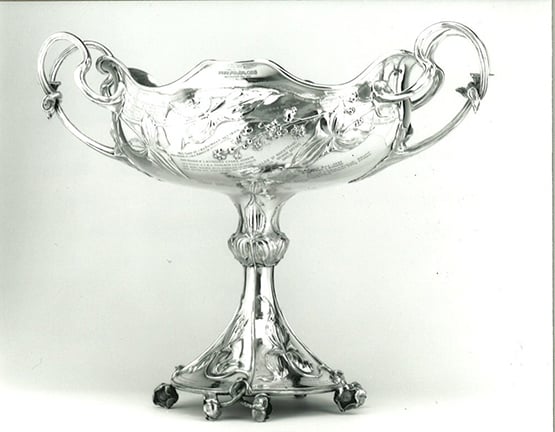 The cause of all the trouble – the One Ton Cup was presented to the CVP by the Earl of Granard, future Commodore of the National YC, in 1898, and was first raced for in 1899.
The cause of all the trouble – the One Ton Cup was presented to the CVP by the Earl of Granard, future Commodore of the National YC, in 1898, and was first raced for in 1899.
The magnificent cup remained as beautiful as ever, but with World War II it became almost forgotten until 1965, when the CVP proposed using it for an inshore-offshore international series for yachts rating at 22ft under the RORC rule, which worked out to be boats around the 36-37ft mark. The idea took off like a rocket - level-rating racing among diverse boats was an idea whose time had come. Very quickly, a whole range of additional international rating levels arose, with Two Tonners around 40-42ft, Three Quarter Tonners around 34ft, Half Tonners around 30ft, Quarter Tonners around 25ft, Mini-Tonners around 21ft, and they even had Micro-Tonners at about 18ft.
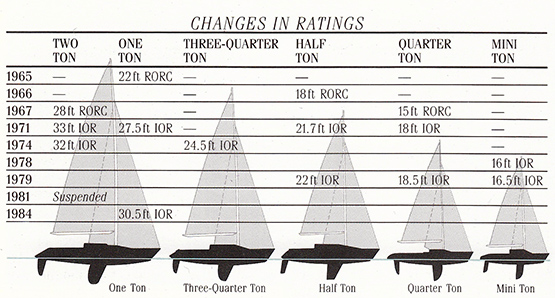 The Ton Classes at their peak
The Ton Classes at their peak
It all worked very well for twenty years and more in some cases (the last Half Tonner was built in 1992), with the boat sizes staying broadly the same size range, but with the ratings changed to accommodate the RORC rule being replaced by the IOR. And Irish sailing certainly had its moments in this continuing circus of various offshore racing acts. In 1974 the Ron Holland-designed, Cork–built 36ft Golden Apple somehow became more famous than the winner by being runner up the One Ton Worlds. But then in 1976, Harold Cudmore and a youthful crew from Cork put all questions aside by managing to get the new race-prepared Ron Holland-designed 30ft Silver Shamrock to Trieste for the Half Ton Worlds, and he won in style, famously celebrating by sailing up the Grand Canal in Venice with spinnaker set.
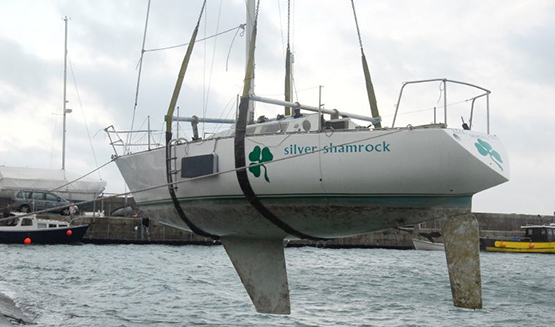 The 1976 Half Ton World champion Silver Shamrock, getting an end-of-season lift-out at her current home port of Penzance in Cornwall
The 1976 Half Ton World champion Silver Shamrock, getting an end-of-season lift-out at her current home port of Penzance in Cornwall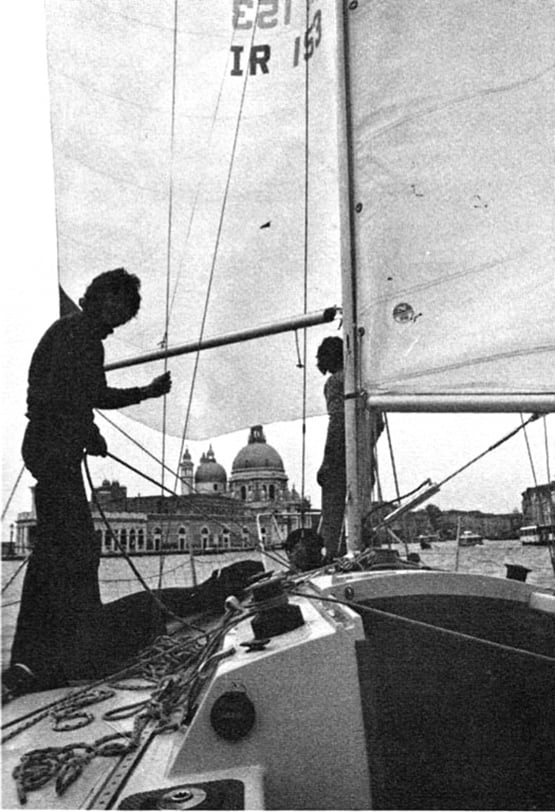 See the conquering heroes come…….Silver Shamrock sailing up the Grand Canal in Venice after winning the Half Ton Worlds 1976 in Trieste under Harold Cudmore’s command. Ronnie Dunphy on left, Killian Bushe on foredeck
See the conquering heroes come…….Silver Shamrock sailing up the Grand Canal in Venice after winning the Half Ton Worlds 1976 in Trieste under Harold Cudmore’s command. Ronnie Dunphy on left, Killian Bushe on foredeck
In 1981 he was back on top again, winning the One Ton Worlds at Crosshaven with the Castro-design Justine IV owned by Frank Woods (NYC). But by this time the boats involved were very different in form from those skinny-sterned designs which had dominated in the earlier 1970s, as a fresh wave of New Zealand designers like Bruce Farr and Laurie Davidson had been showing what could be achieved with broader sterns and better offwind performance.
The Half Ton Worlds was won in 1977, ’78 and ’79 by Kiwi boats of this type. But though she was not the overall winner, Ian Gibbs’ Farr-designed Swuzzlebubble was the one everyone remembered best, as she was on the podium one year as a centreboarder, and back there in the top three the year after, but this time as a keelboat.
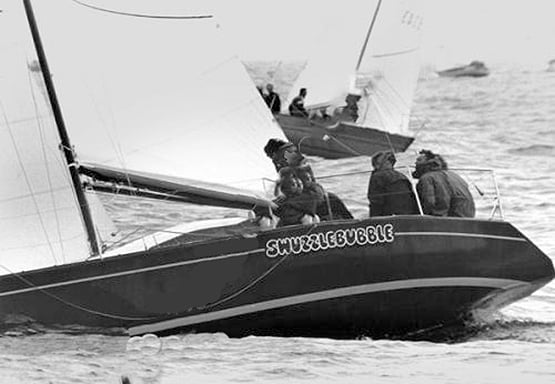 The new wave arrives from New Zealand – Swuzzlebubble in 1979
The new wave arrives from New Zealand – Swuzzlebubble in 1979
The following year she arrived in Ireland in the ownership of Bruce Lyster of Royal St George in Dun Laoghaire, and he won the ISORA Championship in 1980, plus ISORA Week and just about everything for which the boat was eligible in Cowes Week.
He had an exceptional crew of all the talents with Robert Dix, Drewry Pearson and Des Cummins, and Dixie remembers her as one of the most wonderful boats he ever sailed: “She found her own way to peak performance so effortlessly that you’d almost be scared to do anything which might adversely effect the trim” he quips.
He continues to say that even though Bruce Lyster sold Swuzzlebubble to Greece at season’s end, as you simply couldn’t improve on a season like they’d had in 1980. The Three Musketeers meanwhile transferred aboard Ken Rohan’s 40ft Regardless, with which they won their class big time in the 1981 Fastnet.
Regardless would be on most people’s short list for the greatest Irish racing yacht ever, yet Robert Dix remembers the previous season with Swuzzlebubble with even more enthusiasm. So it’s intriguing that at next week’s Henri Lloyd Half Ton Classics Worlds, the new wave of Irish Classic Half Ton sailors will be taking on Swuzzlebubble for the first time.
The story of her re-birth is typical of the modern revival of the very best of the old Ton Cup boats, with the One Ton Championship itself being revived for its Golden Jubilee in New Zealand in 2015 with a classic fleet. As for Swuzzlebubble, she was discovered in a very poor way indeed in a Greek boatyard in 2012, but was brought back to life by the King of Cowes, Peter Morton, who duly won the Half Ton Classics Worlds in Brittany in 2014 with her.
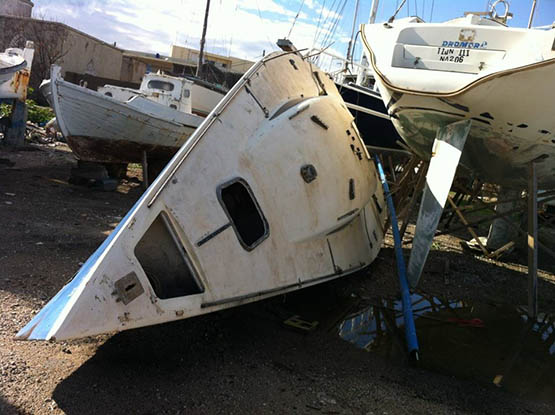 Next stop, the landfill site? Swuzzlebubble as she was found in Greece in 2012
Next stop, the landfill site? Swuzzlebubble as she was found in Greece in 2012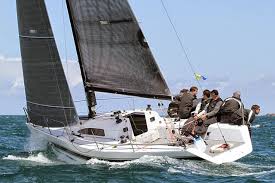 Swuzzlebubble restored, on her way to winning the Half Ton Classics in Brittany in 2014
Swuzzlebubble restored, on her way to winning the Half Ton Classics in Brittany in 2014
However, Swuzzlebubble wasn’t campaigned in the 2015 series in Belgium, when Dave Cullen took the trophy for Ireland with Checkmate XV. So there has been an air of unfinished business about these two rather special boats floating about the ocean without actually locking horns, but that’s all going to be changed in Falmouth.
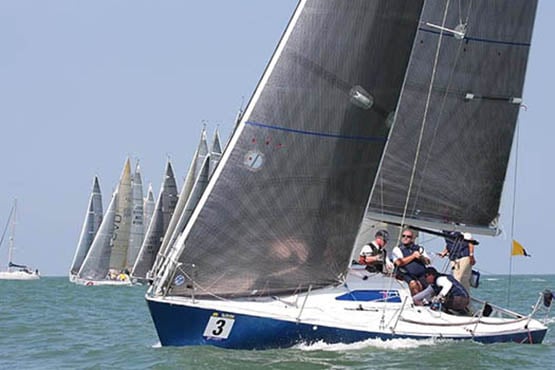 Dave Cullen on the helm as Checkmate XV makes a start to die for at the Half Ton Worlds in Belgium, 2015
Dave Cullen on the helm as Checkmate XV makes a start to die for at the Half Ton Worlds in Belgium, 2015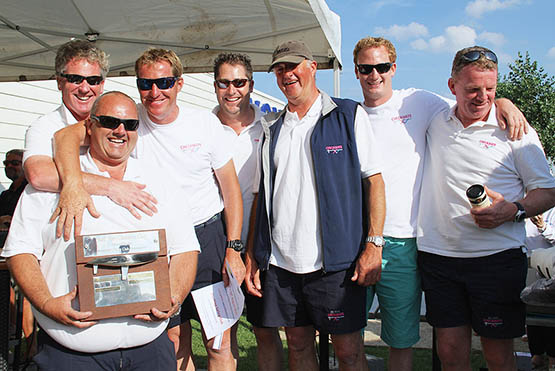 Winners take all – Dave Cullen and his crew with the trophy after victory last year
Winners take all – Dave Cullen and his crew with the trophy after victory last year
In fact, it has become Howth versus Falmouth, as Swuzzlebubble is now Falmouth-owned by Gregory Peck who, in a very varied sailing career, was one of the crew with Dickie Gomes aboard the 83ft catamaran Novanet when a new Round Ireland Record was established in November 1986, but that’s another story altogether.
However, in Falmouth there’ll be other boats involved too, as the word is they might muster as many as 30 entries, which is as big a fleet as anyone could reasonably wish for. The remarkable Howth/Fingal contingent will be there in full strength, as Checkmate XV will be taking the road with Jonny Swann’s Harmony, Michael and Richard Evans’ The Big Picture, and the David Kelly and Patrick Boardman team from Rush SC with King One, Half Ton World Champion in 1981.
It’s an intriguing mixture of nostalgia and modernity, as the boats get revamped to new ideas, yet they always carry their history lightly but definitely with them. In the case of the Howth boats, much of the technical work in revamping is done by ace boatbuilder Alan Power of Malahide, who appropriately is a powerboat nut himself, but his ability to think outside the usual boat-building box makes him the ideal man to undertake crazy notions for addicts of old but still potent offshore racers.
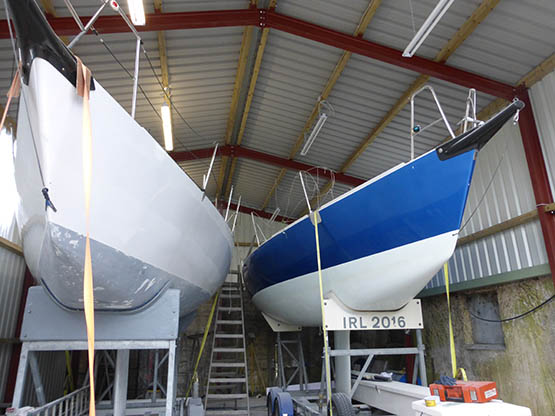
In line with this aim of maximising performance, the Howth/Fingal crewing lineup will include some formidable talent from all over Ireland, with Dave Cullen leading the charge with his 2015 crew of Johnny Murphy, Gary Cullen (no relation), Aidan Beggan, Mark Pettit, James Hynes and Andy George.
The crew on The Big Picture meanwhile have roped in Mark Mansfield of Cork, who is having a great year of it in a variety of boats, while the jockey for King One is young Marty O’Leary, one of the bright new talents to emerge in recent years from Courtown in County Wexford.
Down Falmouth way, it’s going to be Classic Half Ton Racing at its classic best. And if you wonder why it is that the Half Tonners seem to have been the most successful of all the Ton classes in reviving themselves after more than fifty years, perhaps the answer is that at 30ft they’re big enough as boats to be taken seriously, yet small enough to be a manageable proposition for keeping in top order and raced keenly.
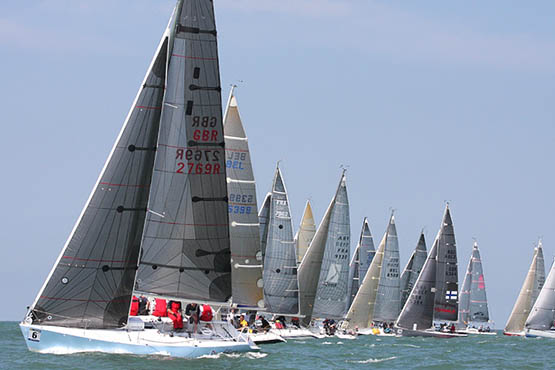 The contemporary Half Ton Classics lineup – the boats are big enough to be taken seriously, yet small enough to be manageable
The contemporary Half Ton Classics lineup – the boats are big enough to be taken seriously, yet small enough to be manageable
Superyacht 'Grace E' Calls to Kinsale
The latest superyacht visitor to Kinsale Yacht Club Marina makes quite an impact alongside at the yacht club pontoon today.
'It's not too often we get these large boats into visit' Matthias Hellstern, Kinsale Yacht Club's Rear Commodore told Afloat.ie
‘Grace E’ is a Superyacht, 73 metres in length and built in 2014 by Perini Navi Group Italy. She won Motor Yacht of the Year at the World Superyacht Awards 2015
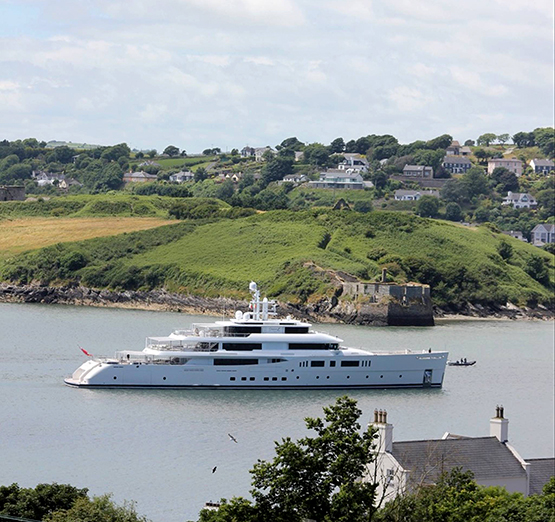 Superyacht 'Grace E' moored in Kinsale harbour
Superyacht 'Grace E' moored in Kinsale harbour
Kinsale Yacht Club Frostbite Titles Up for Grabs
The third week of the Frostbites in Kinsale Yacht Club was run under testing conditions today. When the Committee Boat, got to the racing area there was barely 5 knots of breeze, compounded by the fact that it was out of the NE and there was a very strong tide ebbing, the windward leg was definitely challenging for the competitors.
9 Squibs were on the start line. 1st race saw Viking Gold, Jeff Condell and Jeff Cochrane, trying hard to hold his position at the Committee Boat end of the line but he got pushed OCS and had to go around. Allegro, Colm Dunne and Rob Gill and Fagin, Cliodhna and Finbarr O’Regan, were neck and neck for the first two legs. Colm came down on starboard on a higher line, Cliodhna ran a more direct line to the mark. However Colm jibed onto port and reached in at speed to take the mark and this was to prove a decisive move in the race. Viking Gold put in a great race and despite the recall managed to overhaul the fleet to take 3rd.
The wind picked up to 8 – 10 knots for the next 2 races which made the challenging beat a little easier. Allegro took command from the start by finding clean air on the line. Fagin and Viking Gold were tick tacking for 2nd place. John Stanley and Alastair Christie on Bateleur and Denis and Brid Cudmore on Sensation were not far behind. Fagin rounded the leeward mark ahead and secured 2nd. Viking Gold decided to come up to the finish line on the left side of the course and this paid off by securing him 3rd place ahead of Sensation and Bateleur.
The final race again saw an OCS, this time Fagin got squeezed over the line and had to come around. Allegro and Viking Gold both got clear starts, Allegro rounded the windward mark first and managed to hold the lead for the rest of the race. Bateleur rounded the windward mark in 3rd and had a very strong race. Despite the recall Fagin picked off the fleet one by one and with some serious hiking by Finbarr and great helming by Cliodhna just managed to get ahead of Bateleur on the last tack to the line to take 3rd. Next week Allegro is away so Viking Gold and Fagin have it all to play for.
The Laser Fleet saw only 3 competitors today as 1st & 2nd in the series are away training. Mathias Hellstern took command of each of the races to take 3 bullets, Chris Baker put in a steady performance to come 2nd each race with Nic Bendon taking 3rd. Hopefully next week will see a larger turnout of Lasers.
SCORA Sailors Head For Kinsale Yacht Club Hosted AGM
The South Coast Offshore Racing Association (SCORA ) Annual General Meeting will take place on March 11th, 2016, at Kinsale Yacht Club at 8pm writes Claire Bateman.
The agenda is set out below and it looks like there should be a good evening of discussion and plans for the coming season. Another topic that will come up is the future of club cruiser racing (if any) other than the big events like Spring and Autumn leagues.
The season is looking good all round in all classes with lots of interest being shown from the Juniors through to the Seniors.
Light refreshments will be served and there will be a chance to renew acquaintances and for those receiving prizes to enjoy the anticipation.
AGENDA
1. Apologies
2. Commodore’s Report
3. Income/Expenditure Account
4. Election of Commodore
5. Class Bands:
Class Bands for 2016
Class 0 1.050 and above
Class 1 1.049 to 0.975
Class 2 0.974 to 0.916
Class 3 0.915 to 0.865
Class 4 0.864 and below
This is NO CHANGE from 2015.
6. 2016 Sailing Programme – what do the competitors want?
7. SCORA – last year we asked what future?
8. Following the whitesail discussion last year – what next?
9. Any other business
10. Presentation of Prizes




























